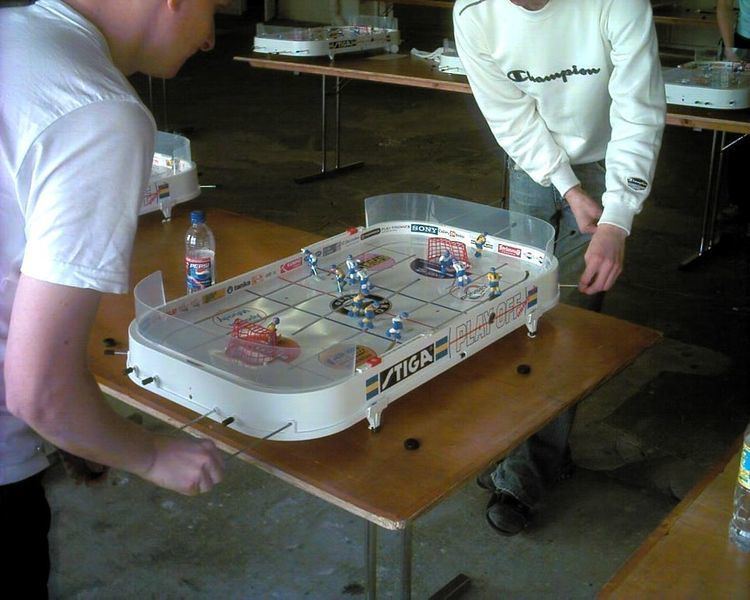 | ||
Table hockey is a sport played on table hockey games. The International Table Hockey Federation (ITHF) uses only table hockeys made by Stiga. The origin of the sport was the Swedish Championship 1982 in Upplands Väsby. Organized table hockey is played in Northern, Central and Eastern Europe, in North America, but table hockey also play some players from South America, Africa, Australia, or Asia.
Contents
- History
- Game rules
- Game model and preparation
- Playing figures
- Matches
- Face offs
- Scoring
- Goal crease rule
- Possession rule
- Interference
- Interruption
- Tournaments
- Level 1 Tournaments history
- Level 2 Tournaments
- Level 3 Tournaments
- Level 4 Tournaments
- Level 5 Tournaments
- Level 6 Tournaments
- World Table Hockey Tour
- ITHF World ranking
- ITHF ranking nations
- References
The World Championship is organized by the ITHF every two years. The Stiga Play Off game is the official game of the Table Hockey World Championship.
Sweden has dominated the table hockey scene from the beginning and a couple of years into the new millennium. Until the Finnish gold in Riga 2005, Sweden had won all Team World Championships, until 2006 only Swedes had won the Open Swedish Masters, and until 2007 all individual world champions were Swedes. But the new generation comes from Finland, Russia, Ukraine, the Czech Republic and Latvia, and its current big star is Maxim Borisov from Russia who is the reigning World and European champion. Borisov has been ranked #1 in the world since December 2013.
Since the sport expands quickly in many countries, the table hockey map may have to be redrawn within a couple of years when nations other than the big seven (Sweden, Finland, Russia, Czech Republic, Norway, Latvia and Ukraine) produce new talents.
History
First table hockeys were made in the 1930s in Sweden and Finland. Naturally there was no plastic, so they were made from sheet metal.
The use of plastic brought an expansion of table hockey. The Swedish company Stiga started to make hockey tables in the late 1950s. Thanks to the enthusiasm of Swedish players, table hockey expanded to the rest of the world.
Big worldwide development arrived in the late 1990s. That led to an idea founding an international federation. ITHF was established during the World Championship 2005 in Riga, Latvia. Now it associates sixteen national federations.
Especially in Sweden, Finland, Russia, Czech Republic, Norway and Latvia, table hockey is quite popular. But it is growing in lots of countries and there are many tournaments played every week.
Game rules
These are the most important rules. Whole rules.
Game model and preparation
Playing figures
Matches
Face-offs
Centre forwards and left defenders must stay on their own side of the centre red line during a face-off.
Scoring
Goal crease rule
Possession rule
Interference
Interruption
Tournaments
The ITHF divides individual tournaments to six levels.
Level 1 Tournaments history
World Championships, Continental Championships
Level 2 Tournaments
World Tour Big 6 (now World Tour Majors and World Tour Super Series)
Level 3 Tournaments
World Tour, Regional Championships (f.i. Baltic Championships), World Championships Special Classes (Junior, Women, Veteran), Continental Championships Special Classes (Junior, Women, Veteran), Continental Tours (North American Tour), National Championships (only if 1 tournament per season)
Level 4 Tournaments
National Tours (*maximum 13 per season per nation), Regional Tours (f.i. SLO-CRO Interliga), National Championships Special Classes (Junior, Women, Veteran), Regional Championships Special Classes (Junior, Women, Veteran), North American Local League Playoffs (f.i. Lemont THL Playoff)
Level 5 Tournaments
Sanctioned Local Leagues, National Championships Special Classes (Kids, SuperVeterans, Rookies)
Level 6 Tournaments
National Tour Special Classes (Junior, Women, Veteran), Local Leagues for Special Classes (Junior, Women, Veteran), Local Junior Tournaments, All Other Tournaments
World Table Hockey Tour
In 2003/04, the first worldwide league, EuroLeague, was created. 6 tournaments formed the league, The tournaments were Helsinki Open, Oslo Open, Riga Cup, Swedish Masters, Moscow Open and Czech Open.
The league has changed name to World Table Hockey Tour, and consists every year of around 15 tournaments. The original 6 tournaments are still regarded as the most important tournaments, and are called the Big Six tournaments.
List of all ITHF tournaments played. Click on the links to see playoff results:
ITHF World ranking
The World ranking table sorts players by their actual rank points. The ranking is sum of player's best results in last two years. Points, which player gets for participating in any reported tournament are counted on the basis of: level of the tournament, number of players beaten and world ranking of players beaten. A winner of the World Championship gets always 1010 points and a winner of Europe Championship and North America Championship gets at least 510 points. World ranking with a reduced coefficient calculated points to six years. In the world ranking is more than 10 000 players from more than 50 countries and six continents.
ITHF ranking - nations
Rank points of a country is sum of its five best players. The table below shows top ten nations as of June 22, 2016. Complete table
